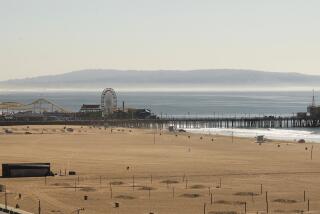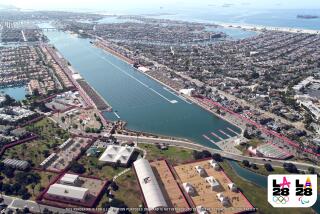Baseball Complex Pitched for Santa Paula
The crack of the bat, the roar of the crowd and the scent of orange blossoms--it’s baseball Santa Paula style, and city officials hope it’s coming soon to a field near them.
The idea is to build a 100-acre “Hall of Fame Tournament Park” jammed with at least 10 baseball fields where traveling tournament teams and fantasy camps will pay to play throughout the year. And as those visitors swing, bunt and hit, city officials hope they will also drop money into local hotels, restaurants and shops.
An enthusiastic Santa Paula City Council voted unanimously last week to continue working on the project--the city will apply for $1 million in federal grants and is putting the multimillion-dollar park on a fast track through the permitting process.
Youth teams would use the fields 42 weeks each year. Planners say up to 1,200 players and their families could participate each week. The city would also be able to use the fields when they were not being used for tournaments.
“This type of business will bring a lot of young people to town and pretty soon you are filling up your hotels, restaurants and downtowns with visitors,” City Manager Peter Cosentini said. “Tourism is an emerging business in Santa Paula. It would be a wonderful boom for the city.”
The idea was presented to the council by Frank Mutz, a former minor league baseball player and mortgage banker in Westlake Village. He and his partners, George and Rick Hocutt, founded the Hall of Fame Tournaments business more than a year ago and have since searched for a place to build a park. The partners settled on Santa Paula after considering land in Simi Valley, Oxnard and, most recently, Fillmore.
“Santa Paula has all the factors that we need to make it work. It has a receptive city council, an area we think we can fit in to, a block of land that would work for us and it’s near the ocean and Magic Mountain,” said George Hocutt, 74, a Santa Clarita businessman who once owned a record distribution company. “It’s just a nice little community.”
But the project faces several hurdles. The 100-acre parcel on the east end of the city where the company hopes to build is owned by Limoneira Co. If the citrus and avocado farming company sells, it can no longer spray pesticides or fertilizer on the adjoining 400 acres because of the nearby baseball fields. Cosentini said he and Limoneira are discussing new uses for the remaining land.
Limoneira President Pierre Tada said he is interested in the project if it helps the city, but he said he hasn’t heard from the developers in more than six weeks.
“They said they wanted to buy 100 acres, but they haven’t called us back,” Tada said. “We don’t know what they want or what they are willing to offer. There has been no price or anything offered so far. We have nothing in writing.”
Then there is the SOAR initiative, which prohibits development on agricultural land without a vote. City officials are studying whether, in this case, they are exempt from SOAR because a park is being built rather than homes.
Finally, the question remains whether the fledgling sports company can raise the estimated $10 million that Hocutt says is needed to build the complex. Hocutt said they are “well on our way” to raising the money, but he declined to say how much they have.
The business group left a bad taste in the mouth of Fillmore City Manager Roy Payne.
Payne said Fillmore seriously pursued the baseball idea, and hired consultants to examine the feasibility of the project in December. When negotiations over land use broke down, Payne said, the other side walked away and never contacted him again.
“They failed to tell us why they left,” Payne said. “We attempted over several months to contact them, but they failed to return our calls. If you are going to do business with them, you need to get it all up front in writing.”
Hocutt said his company couldn’t find enough contiguous land in Fillmore and he apologized if Payne felt the negotiations were abandoned. “If we did that then we did wrong,” he said.
Cosentini, Santa Paula’s city manager, recommended to the council that the city apply for a $1-million federal economic development grant to build and improve local roads and other infrastructure to handle the increased traffic.
“It’s very conceptual at this time,” Cosentini said.
City Councilman Ray Luna was cautiously enthusiastic. “I feel the city and county together can prosper by having this kind of project, but whether it will ever happen, I don’t know,” he said.
More to Read
Sign up for Essential California
The most important California stories and recommendations in your inbox every morning.
You may occasionally receive promotional content from the Los Angeles Times.










